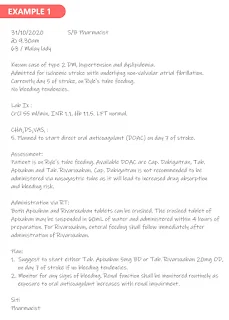Medical Note Entry
Introduction
Medical/case note entries are legal documentation of all contributions made by healthcare providers in a patient's care.
- It facilitates effective communication among healthcare providers by enabling the sharing of concise, informative and auditable records.
- Therefore, it is essential for a pharmacist to make proper medical/case note entries (if applicable).
Medical Documentation
Clinical note entries shall be non-judgemental, provide accurate information and practical recommendations regarding patient care and be politely written.
- Notes shall be limited to information related to the assessment or recommended plan only.
Entry by pharmacist into the clinical case note
- Start by writing the date and time on the top, left-hand corner of the note (for paper or non-form notes).
- Write a header that indicates the note is from the pharmacy.
- At the start of a note, identify patient's age and gender, the reason for interaction with the patient and the condition(s) for which the patient is seeking or receiving therapy.
- May follow the format of Subjective-Objective-Assessment-Plan (SOAP).
- At the end of the note, there shall be signature, name and designation of pharmacist.
Example of pharmaceutical care and interventions which can be documented in medical/case notes by pharmacists include
- Clarification of a medication history
- Details of patient education provided or medication counselling reporting
- TDM, TPN information and recommendations
- Medicines-related issues that warrant close monitoring
- Answers to queries raised by the doctors or other healthcare professionals
- Information or advice given to patients or clinician
- To alert clinicians when a medicines review and monitoring is required
SOAP Note
The most common - and universally recognized - format for documenting patient information in the healthcare system is the SOAP note.
S - Subjective
- Chief complaint - Complaints/symptoms or reason for the visit from the patient in his or her own words
- History of present illness - Recent history that pertains to those symptoms
- Past medical history
- Medication history, including compliance and adverse effects (from the patient, not the computerized medication profile)
- Allergies
- Social and/or family history
- Review of systems
O - Objective
- Vital signs
- Physical findings or physical examination (if possible)
- Laboratory test results (from the lab if available, not from the patient)
- Serum drug concentrations (if available)
- Various diagnostic test results (if available)
- Computerized medication profile with refill information (if available)
A - Assessment
- Involves critical thinking and analysis of the subjective information and objective information to determine the patient health status and drug-related problems.
- If a problem is identified for the first time, adding a notation of "newly identified" after the problem is helpful.
- Likewise, for a follow-up assessment or re-evaluation of a problem, adding "resolved", "worsened" or "stable" is also helpful.
P - Plan
- Involves actions that were - or need to be - taken to resolve any problems that have been identified. Examples:
- Patient education (with counselling points).
- Plan for monitoring of efficacy or side effects.
- The alternatives to treatment if efficacy is not achieved or if toxicity occurs.
- Sufficient detail needs to be included, but without being too lengthy.
- May include guidelines concerning what should be done with the data at the time of follow-up.
- A critical component of the plan is follow-up to ensure that problems are actually corrected, future problems do not develop, and drug therapy goals are met.
NOTE: Evidence from literature/drug references shall be quoted (if possible) when recommending a particular treatment.
Examples
Examples below are taken from Guideline on Ward Pharmacy Activities, 2023.
Summary
Creating clear and concise medical notes is essential for effective healthcare.
- They facilitate communication between providers, improve patient safety by minimizing errors, ensure legal compliance, and demonstrate professionalism.


Comments
Post a Comment